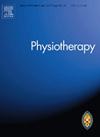灌注生理盐水联合胸部物理治疗对诊断为呼吸机获得性肺炎的成人分泌物清除的疗效:一项随机交叉可行性试验
IF 3
3区 医学
Q1 REHABILITATION
引用次数: 0
摘要
重症监护病房(icu)机械通气(MV)患者常规接受胸部物理治疗,以帮助分泌物清除。物理治疗师可能会将生理盐水注入气管内,以帮助分泌物清除。然而,关于生理盐水注入(SI)的使用,证据有限,英国也没有指南。目的探讨胸腔物理治疗期间SI对呼吸机获得性肺炎(VAP)患者分泌量影响的可行性。方法对英国一家大型ICU的VAP患者进行随机交叉可行性试验。患者接受每日两次的胸部物理治疗,连续3天或直到拔管。主要结局是可行性测量:招募、保留和协议保真度。次要结局包括安全结局和分泌量,采用两种方法评估:“调整湿痰重量”和“痰粒重量”。结果在32例符合条件的患者中,94% (N = 30)被招募,其中7% (N = 2)随后被撤回;21例(70%)完成了所有六个疗程。SI疗程中未发生不良事件。调整后的湿痰重量似乎低估了SI过程中的分泌量,导致负中位数(- 0.49 g;IQR:−2.39,1.11),显著低于非si组(中位数:0.99 g;Iqr: 0.26, 2.11;p & lt;0.001)。使用痰粒重量进行的分析逆转了这种影响的方向,SI组和非SI组的中位数分别为3.49 g (IQR: 1.96, 5.55)和1.70 g (IQR: 0.99, 2.60) (p <;0.001)。结论在MV合并VAP患者的胸部物理治疗中进行SI试验是可行的。然而,在进行最终试验之前,需要进一步验证处理痰样本的方法。•一项前瞻性研究调查生理盐水灌注对分泌量的影响将是安全可行的。调整后的湿痰重不是量化痰量的可靠客观指标。开发和验证处理痰样本以获得准确痰质量的方法是研究重点。本文章由计算机程序翻译,如有差异,请以英文原文为准。
Efficacy of instilled saline in conjunction with chest physiotherapy on secretion clearance in adults diagnosed with a ventilator acquired pneumonia: a randomised crossover feasibility trial
Introduction
Chest physiotherapy is routinely provided to mechanically ventilated (MV) patients in intensive care units (ICUs) to aid secretion clearance. Physiotherapists may instil saline down the endotracheal tube to aid secretion clearance. However, there is limited evidence and no UK guidelines on the use of saline instillation (SI).
Objective
To evaluate the feasibility of a definitive trial examining the efficacy of SI during chest physiotherapy on secretion yield in patients with ventilator-acquired pneumonia (VAP).
Methods
A randomised crossover feasibility trial was performed on patients with VAP at a large UK ICU. Patients underwent twice daily chest physiotherapy sessions, alternating between SI vs. Non-SI for three days or until extubation. Primary outcomes were feasibility measures: recruitment, retention, and protocol fidelity. Secondary outcomes included safety outcomes and secretion yield, assessed using two approaches: “adjusted wet sputum weight” and “sputum pellet weight”.
Results
Of 32 eligible patients, 94% (N = 30) were recruited, of whom 7% (N = 2) were subsequently withdrawn; 21 (70%) completed all six sessions. No adverse events occurred in SI sessions. The adjusted wet sputum weight appeared to underestimate secretion yield in SI sessions, resulting in a negative median value (−0.49 g; IQR: −2.39, 1.11), which was significantly lower than Non-SI sessions (median: 0.99 g; IQR: 0.26, 2.11; p < 0.001). Analysis using sputum pellet weight reversed the direction of this effect, with medians of 3.49 g (IQR: 1.96, 5.55) vs. 1.70 g (IQR: 0.99, 2.60) for SI vs. non-SI sessions (p < 0.001).
Conclusion
A trial of SI during chest physiotherapy for MV patients with VAP would be feasible. However, further validation of a method for processing sputum samples is required before proceeding to a definitive trial.
Contribution of the Paper
- •A prospective study investigating the efficacy of saline instillation on secretion yield would be safe and feasible.
- •Adjusted wet sputum weight is not a reliable objective marker to quantify sputum yield.
- •Development and validation of a method for processing sputum samples to obtain an accurate sputum weight is a research priority.
求助全文
通过发布文献求助,成功后即可免费获取论文全文。
去求助
来源期刊

Physiotherapy
医学-康复医学
CiteScore
6.40
自引率
3.00%
发文量
377
审稿时长
82 days
期刊介绍:
Physiotherapy aims to publish original research and facilitate continuing professional development for physiotherapists and other health professions worldwide. Dedicated to the advancement of physiotherapy through publication of research and scholarly work concerned with, but not limited to, its scientific basis and clinical application, education of practitioners, management of services and policy.
We are pleased to receive articles reporting original scientific research, systematic reviews or meta-analyses, theoretical or debate articles, brief reports and technical reports. All papers should demonstrate methodological rigour.
 求助内容:
求助内容: 应助结果提醒方式:
应助结果提醒方式:


